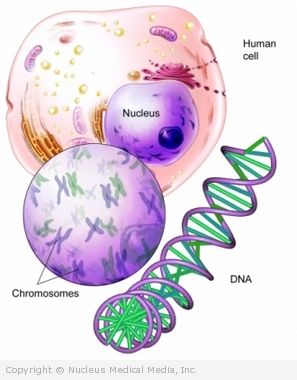Tay-Sachs Disease
Tay-Sachs disease – Definition
Tay-Sachs disease (TSD) is a fatal genetic disorder. It occurs when a fatty substance builds up in the brain. This causes progressive destruction of the brain. There are three forms:
- Infantile-onset
- Juvenile-onset
- Adult-onset
Given the best of care, all children with the infantile form die by the age of five.
Tay-Sachs disease – Causes
TSD is caused by the absence of an enzyme. This enzyme is needed to break down a fatty substance called GM2 (ganglioside). As a result, GM2 builds up. The build up in the brain causes damage.
TSD occurs when both parent pass on the faulty genes. A person can have just one copy of the faulty gene. In this case, there are no symptoms. The person is called a carrier.
Tay-Sachs disease – Risk Factors
Factors that increase your chance for TSD include:
- Having parents who are carriers of the TSD gene
- Race: Eastern European (Ashkenazi) Jewish descent
- TSD is also frequently found in French Canadian and Cajun populations
Tay-Sachs disease – Symptoms
Babies with TSD may seem to develop normally until about 4-5 months of age. There is then an arrest of development. Symptoms begin to occur. Symptoms may include:
- Floppy body position
- Shrill cry
- Decreased eye contact
- Increased startle reaction
- Loss of motor skills
- Enlarged head
- Vision loss or blindness
- Deafness
- Difficulty swallowing
- Muscular difficulties (eg, spastic muscles, weakness or paralysis)
- Intellectual disability
- Seizures
In some cases, the symptoms do not begin until age 2-5 years old. The condition progresses slowly, but most children with Tay-Sachs disease do not live beyond age 15 years. Symptoms may include:
- Loss of the ability to speak
- Developmental delay and intellectual disability
- Loss of bowel control
- Sleep problems
- Movement disorder (eg, gait disturbance, muscle weakness, loss of the ability to walk)
- Tremor
- Slurred speech
- Psychiatric problems
Tay-Sachs disease – Diagnosis
The doctor will ask about your child’s symptoms and medical history. A physical exam will be done. The doctor may examine your child’s eyes to look for a cherry red spot on the retina. Your doctor may also order:
- Blood test — to measure hexosaminidase A activity
Tay-Sachs disease – Treatment
There is presently no treatment for TSD. However, research is ongoing.
Tay-Sachs disease – Prevention
There are no known ways to prevent Tay-Sachs disease. If you are a carrier of the gene that causes TSD, you can talk to a genetic counselor before deciding to have children. Prenatal testing during the first trimester is available.

